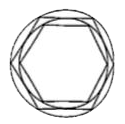A particle of mass m is made to move with uniform speed v0 along the perimerter of a regular hexagon. Inscribed in a circle of radius. R. The magnitude of impulse applied at each corner of the hexagon is :-Solution in Gujrati
2mv0sinπ/6
mv0sinπ/6
mv0sinπ/3
2mv0sinπ/3
The correct Answer is:A

Δp=2pcosπ3=2mv0sin(π6)
Topper's Solved these Questions
- CENTRE OF MASSBOOK - ALLEN CHAPTER - CENTRE OF MASSEXERCISE - EXERCISE-II
43 Videos
- CENTRE OF MASSBOOK - ALLEN CHAPTER - CENTRE OF MASSEXERCISE - EXERCISE-III
41 Videos
- CENTRE OF MASSBOOK - ALLEN CHAPTER - CENTRE OF MASSEXERCISE - EXERCISE-V B
19 Videos
- BASIC MATHEMATICS USED IN PHYSICS &VECTORS BOOK - ALLEN CHAPTER - BASIC MATHEMATICS USED IN PHYSICS &VECTORS EXERCISE - EXERCISE-IV ASSERTION & REASON
11 Videos
- ELASTICITY, SURFACE TENSION AND FLUID MECHANICSBOOK - ALLEN CHAPTER - ELASTICITY, SURFACE TENSION AND FLUID MECHANICSEXERCISE - Exercise 5 B (Integer Type Questions)
3 Videos
Similar Questions
Two particle A and B start moving due to their mutual interaction only. If at any tiem 't', →aA and →aB are their respective accelerations, →vA and →vB are their respective velocities, and upto that time WA and WB are the work done on A and B respectively by the mutual force, mA and mB are their masses respectively, then which of the following is alwys correct.
View SolutionA particle of mass m, kinetic energy K and momentum p collision head on elastically with another particle of mass 2m at rest. After collision. :
Column IColumn II(A)Momentum of first particle(p)3/4p(B)Momentum of second particle(q)−K/9(C)Kinetic energy of first particle(r)−p/3(D)Kinetic energy of second particle(s)8K9None
View SolutionTwo particles of masses m1 and m2 in projectile motion have velocities →v1 and →v2 , respectively , at time t=0. They collide at time t0. Their velocities become →v'1 and →v'2 at time 2t0 while still moving in air. The value of ∣∣∣(m1→v'1+m2→v'2)−(m1→v1+m2→v2)∣∣∣
View SolutionAssertion: If the initial and final positions coincide, the displacement is a null vector.
Reason: A physical quantity can not be called a vector, if its magnitude is zero.
View SolutionTwo soap bubbles A and B are kept in a closed chamber where the air is maintained at pressure 8N/m2.The radii of bubbles A and B are 2cm and 4cm, respectively. Surface tension of the soap-water used to make bubbles is 0.04N/m. Find tha ratio nB/nA, where nA and nB are the number of moles of air in bubbles A and B, respectively. [Neglect the effect of gravity.]
View Solutionif a regular hexagon and regular octagon are inscribed in a circle of radius R then the ratio of areas A_(1), and A_(2), is
View Solution. Find the length of the side of a regular hexagon inscribed in a circle of radius r meters
View SolutionA particle of mass m is made to move with uniform speed u along the perimeter of a regular polygon of n sides. What is the magnitude of impulse applied by the particle at each corner of the polygon?
View SolutionA particle of mass in is made to move with uniform speed v_0 along the perimeter of a regular hexagon, inscribed in a circle of radius R . The magnitude of impulse applied at each corner of the hexagon is
View SolutionA particle of mass m is made to move with uniform speed v_(0) along the perimerter of a regular hexagon. Inscribed in a circle of radius. R. The magnitude of impulse applied at each corner of the hexagon is :-
View SolutionA particle of mass m is made to move with unifrom speed v along the perimeter of a regular hexagon. Magnitude of impulse applied at each corner of the heaxogen is
View SolutionWhat is the difference in the areas of the regular hexagon circumscribing a circle of radius 10 cm and the regular hexagon inscribed in the circle?
View SolutionIf a regular hexagon is inscribed in a circle of radius r, then find the perimeter of the hexagon.
View SolutionIf a regular hexagon circumscribes a circle of radius r , then its perimeter is :
View SolutionA regular hexagon is inscirbed in a circle of radius R . Another circle is inscribed in the hexagon . Now another hexagon is inscribed in the second ( smaller ) circle .

What is the sum of perimeters of both the hexagons ?
View SolutionA regular hexagon is inscirbed in a circle of radius R . Another circle is inscribed in the hexagon . Now another hexagon is inscribed in the second ( smaller ) circle .

What is the ratio of area of inner circle to the outer circle ?
View Solution
